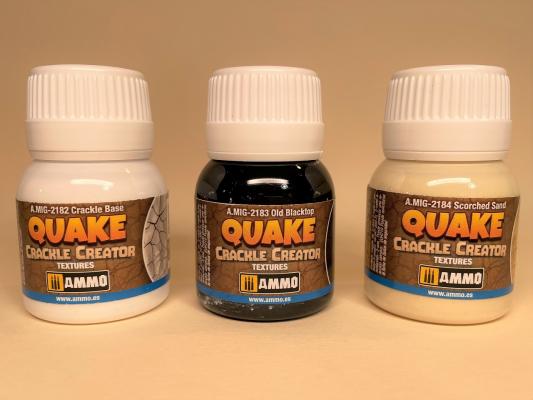Quake Crackle Creator Textures

Ammo’s “Quake Crackle Creator Textures” are a line of thick acrylic paints formulated to dry with cracked surfaces in order to simulate terrain such as dried mud or cracked pavement. Quake is available in five colors: Crackle Base (white), Old Blacktop (black), Scorched Sand (tan), Baked Earth (brown), and Dry Season Clay (red-brown). I’ve tried the first three colors in this review. The product comes in 40ml plastic bottles. The screw-caps are nearly as wide as the bottles and have prominent ridges, so if you get paint on the threads, you can still get the bottles open.
Quake can be applied to dioramas or figure bases with a brush or palette knife. Quake achieves its cracked surface by having a high rate of shrinkage as it dries. I experimented by applying Quake to various surfaces and in varying thicknesses to see how the pattern of cracking was affected. Generally, the thinner the application, the finer the pattern of cracking that results. However, the pattern of cracking is also influenced by how well the Quake adheres to the underlying surface. If there is poor adhesion the pattern will be coarser and more likely to flake from the surface. Ammo recommends applying Quake to primed surfaces. I tried both Tamiya and Ammo primers and found that the Quake adhered much better to the Ammo primer. I Also tried applying Quake to mold-making plaster, heavy paper, wood, Ammo Acrylic Mud for Dioramas, and dried PVA glue (Elmers white glue). The Quake did not stick to the plaster but bonded well to the other surfaces. Thin coats of Quake stuck to primed surfaces fairly well but very thick coats did not. When applying thick coats (thicker than 1mm), it is best to use a rough or porous substrate like wood or Ammo Acrylic Mud. In one of my experiments, I applied a thick layer of Quake to acrylic mud that hadn’t completely cured. The shrinkage of the Quake managed to break the acrylic mud so that the cracks propagated down into the acrylic mud. This could be a good way to simulate deep cracks in pavement or concrete.
When using thick layers of Quake, it is important to keep in mind that it shrinks vertically as well as horizontally. If a thick layer is applied up against a vertical object the quake will dry with a concave surface at the edge. If you want an object to seem embedded in the Quake it may be best to cut off the submerged portions and set them on the wet Quake rather than apply quake onto the object.
The Quake dries with a semi-gloss surface and has no discernable grit to it. When applied in thin layers cracks start to show within a couple of hours, thicker applications may take a day. Ammo recommends waiting 24hours for the product to cure thoroughly. The dried Quake takes paint well making it easy to match other elements in a diorama. I tried both water-based and acrylic washes and both worked well without adversely affecting the dried Quake.
The Quake Crackle Creator Textures are a useful addition to the arsenal of the diorama modeler. After some experimentation to get familiar with the products I found them easy to use and I plan on making more diorama and figure bases with Quake.
I am thankful to IPMS/USA for the opportunity to review these products and to Ammo by MIG Jimenez for their generous contribution of review samples.







Comments
Add new comment
This site is protected by reCAPTCHA and the Google Privacy Policy and Terms of Service apply.